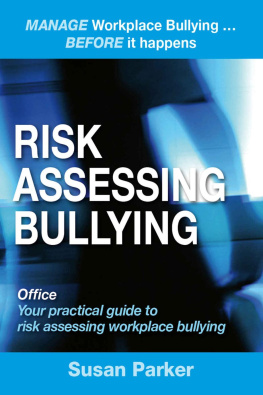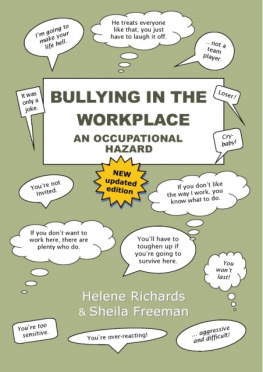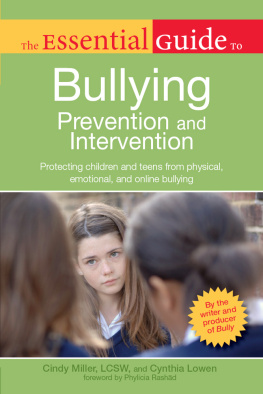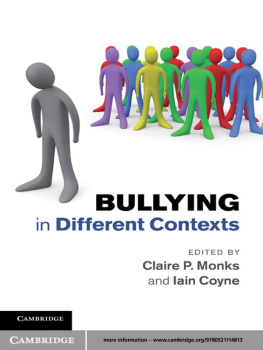The Supervisors Guide
A practical guide for supervisors to use with work teams to risk assess workplace bullying
Risk Assessing Bullying
Manage workplace bullying... before it happens
Copyright Susan Parker 2015
All rights reserved
Legal Notice
It is important to note the advice and examples in this book are intended as a guide only. The contents of this book do not constitute legal advice and it is not intended to be used as a substitute for specific legal advice or opinions. Many of the examples could resemble other peoples situations; this would be purely coincidental, though all incidents are based on true events. The author and publisher have taken reasonable precautions in the preparation of this book and believe the information presented in this book is accurate as of the date it was written. However, neither the author nor the publisher assumes any responsibility for any errors or omissions. The author and publisher specifically disclaim any liability resulting from the use or application of the information contained in this book. It is sold with the understanding that the author is not engaged in rendering professional services. If professional advice or other expert assistance is required, the services of a competent professional person should be sought.
Please access the risk assessment tool specifically designed for this guide by logging onto either:
www.riskassessingbullying.com.au
www.riskassessingbullying.co.uk
www.riskassessingbullying.com
To access the risk assessment tool you will need the secure login and password. The secure login and password are located on the last page of this guide.
The risk assessment tool is in Word format, making it easy to update; and if needed, to upload to your SharePoint site.
Should you experience any difficultly downloading the risk assessment tool, please email with a copy of your Amazon confirmation and the risk assessment tool will be emailed to you in Word format.
Contents
Chapter 1
Introduction to Risk Assessing Bullying
Manage workplace bullying before it happens
Chapter 2
What is Risk Assessment?
What is workplace bullying?
Chapter 3
101 Risk Assessments for Workplace Bullying
Chapter 1
Introduction to Risk Assessing Bullying
Manage Workplace Bullying before it happens
Risk Assessing Bullying, is a guide for managers and supervisors to use with their work teams to discuss risk assessment of bullying, or, incidents which could lead to workplace bullying; as part of their team meetings. Just as you might start your meetings with a safety message, you can now include within your team meetings a risk assessment for bullying. It might be, you delegate someone within your team to risk assess a bullying incident (or an unreasonable behavior which could escalate into bullying) from the risk assessment tool (which can be downloaded from the web site www.riskassessingbullying.com.au - using the secure login and password which are located on the last page of this guide ) to present at the next team meeting, or you may choose an incident for your team to brainstorm; discuss the hazard, explain why the behavior is considered a hazard, a possible response to the behavior, rate the risk to health and safety, discuss the risk rating, talk about how the behavior will be reported and what workplace policies could be used, what are the possible control measures to reduce the risk and how will the introduced strategies be monitored and evaluated. Risk Assessing Bullying already gives you the incidents to risk assess; making risk assessment easy. The risk assessment tool is designed for updating by a team member; or your team (as part of the organizations consultation process with employees on improving health and safety). It is in Word format for easy uploading to your SharePoint site if needed.
Empowering people to know what to do when faced with bullying incidents can build confidence for both individuals and teams. The first three risk assessments in the risk assessment tool are completed. You might use them as a guide to completing the other incidents. There are another 98 to be discussed. Example responses to the negative behaviors are completed for all 101 examples. Risk Assessing Bullying, Manage workplace bullying before it happens, focuses on assessing negative workplace behaviors which could happen in any work environment. The benefit to having predetermined situations allows participants to evaluate what workplace procedures should be used. This guide is for managers and supervisors to assist their employees when they are completing the risk assessment tool.
As your team builds on the risk assessment tool, you may find that changes to your current policies might be needed. Giving staff the opportunity to have input and build on current policies and procedures can empower them to make better choices. It can allow people to take ownership and responsibility for their own health and safety and the confidence to report incidents that might affect the health and safety of others.
Chapter 2
What is Risk Assessment?
Risk Assessment generally uses a set format of steps to follow:
- Identify the hazard
or identify an incident which has the potential to lead to bullying
- Assess the risk to health and safety
What is the likelihood and consequences of workplace bullying occurring?
- Develop and implement strategies to eliminate, reduce or control the risk
The implemented strategies should be consistent with the companys policies, however also accommodate for ongoing consultation and change.
- Evaluate and monitor the implemented strategies
Assess the effectiveness of the control measures implemented.
What is workplace bullying?
Reference, Safe Work Australias Guide for Preventing and Responding to Workplace Bullying, page 2.
1.1 What is workplace bullying?
Workplace bullying is defined as repeated and unreasonable behavior directed towards a worker or a group of workers that creates a risk to health and safety.
Repeated behavior refers to the persistent nature of the behavior and can involve a range of behaviors over time.
Unreasonable behavior means behavior that a reasonable person, having considered the circumstances, would see as unreasonable, including behavior that is victimizing, humiliating, intimidating or threatening.
Though I have used the abovementioned document as a reference, within all democratic countries, all workplace health and safety legislation will support the same principles.
Chapter 3
Risk Assessments for Workplace Bullying
- Identify hazard #1. The dirty look.
- Explanation why the behavior is considered a hazard?
This can be a subtle form of covert intimidation; a hidden form of workplace bullying. In some instances it could be considered aggressive or hostile non-verbal communication. Generally, the intention is to make the co-worker feel confused and apprehensive. Continued negative communication, all be it non-verbal, can create anxiety for teammates. In some cases it can affect their concentration which has the potential to cause reduced performance.
- Example response to the negative behavior:
Jane, when you look at me in a disparaging way, I feel unsettled.
- Health & Safety risk assessment score.
It could be considered a low to moderate risk if its a once off, however if determined a pattern of poor behavior, the risk score could increase the probability of harm.
- Why? Briefly explain why you derived at this score?
Negative communication, including non-verbal, may cause confusion and stress for co-workers, and possibly result in poor health.
- How will the behavior be reported?
Next page












